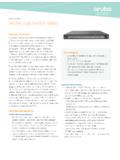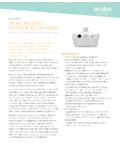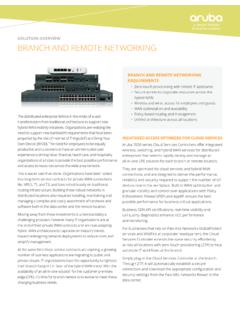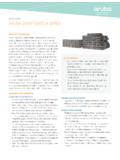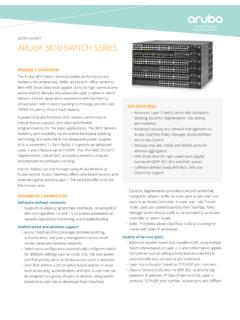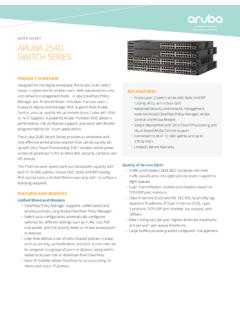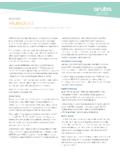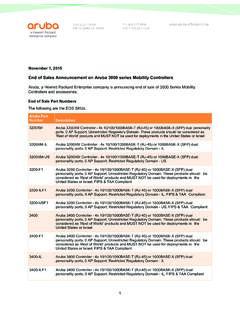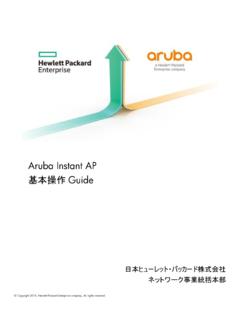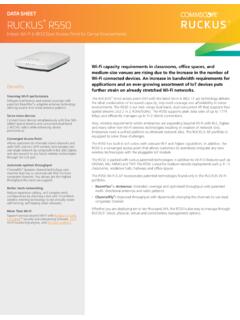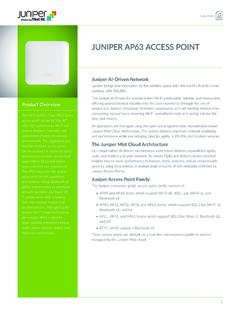Transcription of ARUBAOS
1 DATA SHEETA rubaOS is the network operating system behind our industry-leading wireless solutions. Whether you are deploying wireless across a large campus solution, a mid-sized branch, or supporting remote workers, ARUBAOS delivers the seamless connectivity, security, and reliability that your organization requires. It offers controller-based and controller-less options to meet enterprise demands across all types of industries and supports current standards and interoperability for Wi-Fi standards. SIMPLIFIED DEPLOYMENTD eploying and provisioning network devices is an important but often time-consuming activity for network administrators. With rapid growth in remote work, onboarding becomes a cumbersome activity to support across several disparate locations.
2 ARUBAOS simplifies and automates deployment with the following features: Zero touch provisioning (ZTP): Network configurations can be implemented and distributed from the Mobility Conductor through zero-touch provisioning (ZTP) to all Mobility Controllers or via Aruba Central in controller-less environments to eliminate the need for IT support on site. Remote Access Points (RAPs): Any AP can act as a RAP and can be deployed in disparate locations such as small offices/home offices (SOHO) or temporary work sites. RAPs can simply be shipped to the end-user and administrators can deploy them through zero touch provisioning without any local pre-configuration on the APs. Management, configuration and troubleshooting are provided through a browser-based GUI.
3 Learn more about Aruba s Remote Access Solution. See Table 1 and Figure 1. Multi-tenancy Wi-Fi support (MultiZone): This is ideal for multi-tenancy requirements where multiple organizations are housed in a single office space or for a single organization that requires separate secure networks. MultiZone capabilities can also be used to segment traffic such as IoT or guest traffic within a single tenant for greater security. ARUBAOSE nhanced network operating system for today s digital workplace KEY FEATURES Support for Wi-Fi 6 standards including WPA3, Enhanced Open, uplink MU-MIMO, OFDMA, and Target Wake Time Unified wired and wireless access policies with Dynamic Segmentation to provide secure access for users, applications, and devices.
4 Live Upgrade and Seamless Failover to ensure business continuity and eliminate unnecessary downtime. Channel optimization and client roaming for seamless connectivity and improved user experience. SLA-grade application assurance to improve user experience for latency-sensitive voice and video applications. Automated deployment with zero touch provisioning to rapidly deploy without IT SHEET ARUBAOS2 DESKTOPLAPTOPSMARTPHONEKEYOFFICE/LOCAL NETWORK ENTERPRISE NETWORKVOICE NETWORK BRANCH OFFICE/ TELECOMMUTERENTERPRISE DATACENTER BRANCH OFFICEBRANCH OFFICEACCESS SWITCH PRINTERREMOTE AP (RAP) INTERNET SERVICES INTERNET EXIT POINT SERVERMOBILITY CONTROLLER FIREWALLVOICEF igure 1: Aruba RAPs for secure mobile connectivity to micro-branch and small officesRemote Access Points BenefitsZero-touch provisioningAdministrators can deploy RAPs without any preconfiguration.
5 Simply ship it to the end and wirelessUsers connect to RAPs via wired Ethernet, Wi-Fi or , captive portal, MAC address authentication per-port and managementNo local configuration is performed on APs Configuration and management are done by the Mobility LTE WAN connectionRAPs support USB cellular LTE modems for primary or backup Internet traffic forwarding Centralized all user traffic flows to a Mobility Controller. Locally bridged All user traffic bridged by access device to local LAN segment. Policy-routed User traffic selectively forwarded to Mobility Controller or bridged locally, depending on traffic type/policy (requires PEF license).Enterprise-grade securityRAPs authenticate to Mobility Controllers using certificates and then establish secure IPsec bandwidth reservationDefines reserved bandwidth for loss-sensitive application protocols such as diagnosticsIn the event of a call to the help desk, local users can browse to a predefined URL to access full RAP mesh portalA RAP may also act as a mesh portal, providing wireless links to downstream required link speed64 kbps per SSIDE ncryption protocol (RAP to Mobility Controller)AES-CBC-256 (inside IPsec ESP)Table 1.
6 Remote Access Point BenefitsDATA SHEET ARUBAOS3 AirMatch provides even distribution of radios across available channels to mitigate interference and maximize system capacity, dynamically adjusts between 20 MHz, 40 MHz, and 80 MHz to match the density of your environment , and automatically adjusts the transmit power of APs across the entire network. SLA-grade application assurance: ARUBAOS provides complete orchestration for Air Slice, an application assurance technology unique to Aruba Wi-Fi 6 access points. By allocating radio resources, such as time, frequency, and spatial streams and combined with intelligence gathered by Aruba s Policy Enforcement Firewall (PEF), APs provide guaranteed bandwidth and low latency for specific users and applications.
7 RF OPTIMIZATION Ensuring optimal network performance and seamless end-user experience is becoming increasingly difficult with the growth in bandwidth-intensive applications and latency-sensitive IoT deployments. ARUBAOS employs AI and machine learning to optimize client, application, and operator activities. See Table 2. This includes: Client optimization: Clients that stubbornly remain connected to a single AP even when they roam to an area with APs that offer better connectivity can have a significant impact on the performance of the client and overall network health. Aruba s patented RF optimization technology, ClientMatch, scans APs in the neighborhood to ensure that client devices associate with the best-performing AP. RF optimization: Using machine learning algorithms, AirMatch automates RF channel assignment, channel width, and radio power assignments.
8 It proactively learns and acclimates the network based on changing environmental conditions and system capacity. Machine learning makes dynamic channel assignment, width adjustment, and transmit power adjustment possible. Figure 2: ARUBAOS user interface with dashboards, configuration, diagnostics, and maintenanceDATA SHEET ARUBAOS4 SECURITY AND VISIBILITYThe previous approach of using manual and static configurations does not sufficiently meet the security requirements of highly dynamic mobile and IoT environments. To mitigate risk, ARUBAOS provides network administrators enhanced levels of visibility and advanced features such as: Dynamic Segmentation with Policy Enforcement Firewall: To improve security and ease of management, IT can centrally configure and automatically enforce role-based policies that define proper access privileges for employees, guests, contractors, and other user groups no matter where users connect on wired and WLANs.
9 Dynamic Segmentation eliminates the time consuming and error-prone task of managing complex and static VLANs, ACLS, and subnets by dynamically assigning policies and keeping traffic secure and separated. Policies can be manually created within ARUBAOS or centrally managed by Aruba ClearPass Policy Manager and applied to multiple networks simultaneously. Deep Packet Inspection with AppRF : ARUBAOS provides extensive visibility and control into over 3,000 apps using AppRF that allows for the configuration of security policies and bandwidth controls of applications and application categories. AppRF supports Deep Packet Inspection (DPI) capabilities within the policy enforcement firewall for application classification. Optimizing and limiting traffic per application is simple, and intuitive via an easy-to-use dashboard.
10 Unrecognized applications and categories can also be defined through application customization. Role-based policies also offer the flexibility to control exactly which users can run what applications and unwanted applications can be blocked to conserve bandwidth. Rate limits for applications or application categories permit non-essential traffic while preventing it from overwhelming mission critical applications. Web classification (WebCC): ARUBAOS provides a cloud-based web content classification, policy, and reputation service for URL filtering, IP reputation and geolocation filtering, which helps enforce network acceptable use policies to block and rate-limit connections based on Aruba s identity-based controls. See Figure 3. Enhanced Wi-Fi authentication security: The addition of WPA3 support in the Wi-Fi 6 standard brings stronger encryption and authentication methods, plus Enhanced Open provides per user encryption on open networks.
